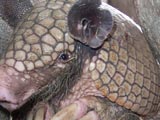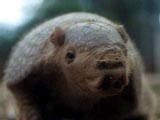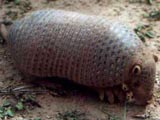Naked-tailed armadillos
Four species of naked-tailed armadillos are recognized: The greater naked-tailed armadillo (C. tatouay), the Chacoan naked-tailed armadillo (C. chacoensis), the northern naked-tailed armadillo (C. centralis), and the southern naked-tailed armadillo (C. unicinctus).
Cabassous tatouay
Greater Naked-tailed Armadillo or Tatouay
- Range:
Southern Brazil, eastern Paraguay, Uruguay, northeastern Argentina.
- Size and Weight:
Head and body length: 300 — 490 mm (11.8 — 19.3 in).
Tail length: 90 — 200 mm (3.5 — 7.7 in).
Weight: 3.4 — 6.4 kg (7.5 — 14.1 lbs).- Description:
Members of the genus Cabassous are closely related to Priodontes, and resemble P. maximus closely except for size. They possess a dark brown to almost black carapace, with yellowish edges. The underparts are yellow-gray. There are five large claws on forefeet, with the middle claw largest. The snout is short and broad, as is the head. There are 10 to 13 moveable bands across the back. Very few armor plates are present on the tail; those that are there are small, thin, and widely separated. The tail is slender and shorter than the body.
- Habitat:
Lives in a variety of habitats, including grasslands, semiarid and moist lowlands, upland areas, and riversides. Generally dig burrows in open ground or near the base of an embankment. Have not been known to construct nests.
- Ecology:
C. tatouay walks on the tips of the claws on the forefeet, and the soles of the hind feet. This species can run quite rapidly for short distances when pursued, but more slowly than D. novemcinctus. The animal generally burrows or goes to water to escape. Members of the genus Cabassous are nocturnal. C. tatouay feeds mostly on termites or ants, located by smell from leaf litter and soil. The animal uses its large, sickle-shaped third claw to cut small roots as it digs for food in rotting stumps or dead roots, using the long tongue to extract insect prey from tunnels. C. tatouay sometimes completely buries itself while digging for food.
- Biology:
The young are born singly. C. tatouay is listed as near threatened by the IUCN.
- Pictures:
-
Do you have a picture of C. tatouay that you would like to donate to this site? Please see the Armadillos Wanted page to see how you can help.
Cabassous chacoensis
Chacoan Naked-tailed Armadillo
- Range:
Gran Chaco of southeastern Bolivia, western Paraguay, northern Argentina; probably also found in adjacent part of Brazil.
- Size and Weight:
Head and body length: 300 — 490 mm (11.8 — 19.3 in).
Tail length: 90 — 200 mm (3.5 — 7.7 in).
Weight: Unspecified.- Description:
Members of the genus Cabassous are closely related to Priodontes, and resemble P. maximus closely except for size. They possess a dark brown to almost black carapace, with yellowish edges. The underparts are yellow-gray. There are five large claws on forefeet, with the middle claw largest. The snout is short and broad, as is the head. There are 10 to 13 moveable bands across the back. Very few armor plates are present on the tail; those that are there are small, thin, and widely separated. The tail is slender and shorter than the body.
- Habitat:
Lives in a variety of habitats, including grasslands, semiarid and moist lowlands, upland areas, and riversides. Generally dig burrows in open ground or near the base of an embankment. Have not been known to construct nests.
- Ecology:
C. chacoensis walks on the tips of the claws on the forefeet, and the soles of the hind feet. This species can run quite rapidly for short distances when pursued, but more slowly than D. novemcinctus. The animal generally burrows or goes to water to escape. Members of the genus Cabassous are nocturnal. C. chacoensis feeds mostly on termites or ants, located by smell from leaf litter and soil. The animal uses its large, sickle-shaped third claw to cut small roots as it digs for food in rotting stumps or dead roots, using the long tongue to extract insect prey from tunnels. C. chacoensis sometimes completely buries itself while digging for food.
- Biology:
The young are born singly.
- Pictures:
-
Do you have a picture of C. chacoensis that you would like to donate to this site? Please see the Armadillos Wanted page to see how you can help.
Cabassous centralis
Northern Naked-tailed Armadillo
- Range:
Extreme southern Mexico and Belize to western Colombia and northwestern Venezuela.
- Size and Weight:
Head and body length: 300 — 490 mm (11.8 — 19.3 in).
Tail length: 90 — 200 mm (3.5 — 7.7 in).
Weight: 2.0 — 3.5 kg (4.4 — 7.7 lbs).- Description:
Members of the genus Cabassous are closely related to Priodontes, and resemble P. maximus closely except for size. They possess a dark brown to almost black carapace, with yellowish edges. The underparts are yellow-gray. There are five large claws on forefeet, with the middle claw largest. The snout is short and broad, as is the head. There are 10 to 13 moveable bands across the back. Very few armor plates are present on the tail; those that are there are small, thin, and widely separated. The tail is slender and shorter than the body.
- Habitat:
Lives in burrows in upland plateaus.
- Ecology:
C. centralis walks on the tips of the claws on the forefeet, and the soles of the hind feet. This species can run quite rapidly for short distances when pursued, but more slowly than D. novemcinctus. The animal generally burrows or goes to water to escape. Members of the genus Cabassous are nocturnal. C. centralis feeds mostly on termites or ants, located by smell from leaf litter and soil. The animal uses its large, sickle-shaped third claw to cut small roots as it digs for food in rotting stumps or dead roots, using the long tongue to extract insect prey from tunnels. C. centralis sometimes completely buries itself while digging for food.
- Biology:
C. centralis is the only armadillo other than D. novemcinctus found outside of South America. The young are born singly.
- Pictures:
-
(No picture available for C. centralis.)
Do you have a picture of C. centralis that you would like to donate to this site? Please see the Armadillos Wanted page to see how you can help.
Cabassous unicinctus
Southern Naked-tailed Armadillo
- Range:
East of the Andes from Venezuela to southern Brazil.
- Size and Weight:
Head and body length: 300 — 490 mm (11.8 — 19.3 in).
Tail length: 90 — 200 mm (3.5 — 7.7 in).
Weight: 2.2 — 4.8 kg (4.9 — 10.6 lbs).- Description:
Members of the genus Cabassous are closely related to Priodontes, and resemble P. maximus closely except for size. They possess a dark brown to almost black carapace, with yellowish edges. The underparts are yellow-gray. There are five large claws on forefeet, with the middle claw largest. The snout is short and broad, as is the head. There are 10 to 13 moveable bands across the back. Very few armor plates are present on the tail; those that are there are small, thin, and widely separated. The tail is slender and shorter than the body.
- Habitat:
Lives in a variety of habitats, including grasslands, semiarid and moist lowlands, upland areas, and riversides. Generally dig burrows in open ground or near the base of an embankment. Have not been known to construct nests.
- Ecology:
C. unicinctus walks on the tips of the claws on the forefeet, and the soles of the hind feet. This species can run quite rapidly for short distances when pursued, but more slowly than D. novemcinctus. The animal generally burrows or goes to water to escape. Members of the genus Cabassous are nocturnal. C. unicinctus feeds mostly on termites or ants, located by smell from leaf litter and soil. The animal uses its large, sickle-shaped third claw to cut small roots as it digs for food in rotting stumps or dead roots, using the long tongue to extract insect prey from tunnels. C. unicinctus sometimes completely buries itself while digging for food.
- Biology:
The young are born singly.
- Pictures:
-
Do you have a picture of C. unicinctus that you would like to donate to this site? Please see the Armadillos Wanted page to see how you can help.
Sources
Nowak, R.M. 1999. Walker’s Mammals of the World, 6th edition. Johns Hopkins University Press, Baltimore, MD. 158-168.
Abbreviations
IUCN: International Union for Conservation of Nature and Natural Resources
USDI: United States Department of the Interior
CITES: Convention on International Trade in Endangered Species of Wild Fauna and Flora
 ] will leave this website.
] will leave this website.






